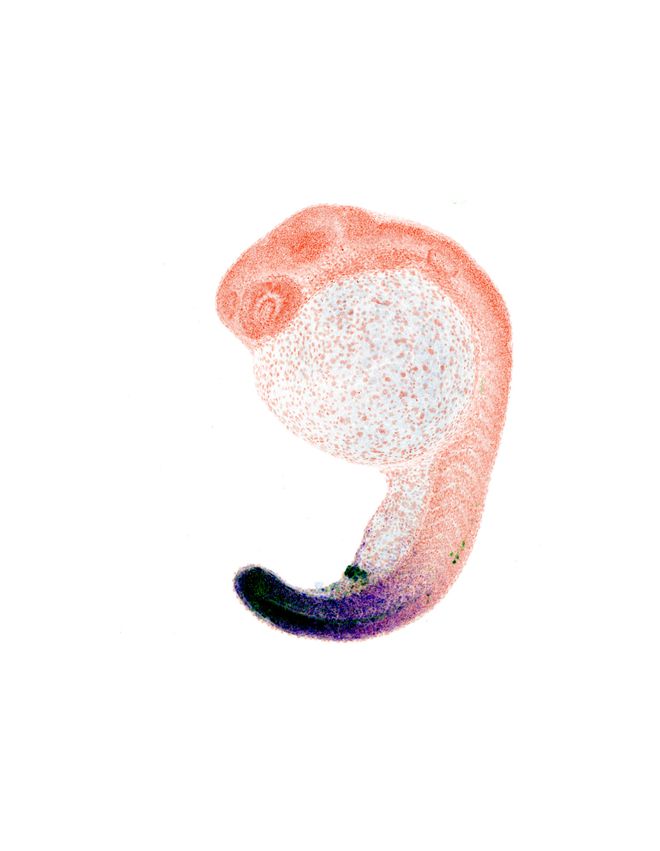Fins, fingers, and toes. Though they might seem similar, it turns out that they aren’t as connected as sometimes suggested.
In fact, a new study in Nature has taken a closer look at how human hands and feet evolved, and has found that their appendages may have emerged from a regulatory region of the genome, active in fish for millions of years, not for the formation of the fins but for the formation of the cloaca — an opening involved in excretion and reproduction.
Talk about a surprise. But, according to the study authors, the results reveal much more than the shocking roots of our fingers and toes, emphasizing the role of recycling in evolution. Indeed, the fishy origin of our appendages stresses that evolution is a thrifty force, reusing the regulatory genes of old structures for new structures over time.
Read More: You May Have Sensitive Teeth Because of This 465-Million-Year-Old Fish
The Elusive Evolution of Fingers and Toes
When fish first emerged from the water around 380 million years ago, they traded their fins for hands, feet, fingers, and toes, evolving limbs to live on land. The appearance of these structures was one of the most important events in evolutionary history, yet how they arose is far from clear, leaving it uncertain whether they came from fins or from something else entirely.

To develop their digits, ancestral tetrapods recycled an ancient region of the genome that was initially active in the formation of the fish cloaca. This is illustrated here by the expression of a Hox architect gene in the cloaca of the zebrafish (black dot).
(Image Credit: © Brent Hawkins, Harvard)
Comparing the coding and non-coding regions of the genomes of fish and mice, the study authors sought to uncover the advent of these appendages. While the coding regions contain the genes that are involved in the formation of anatomical structures, the non-coding regions control the expression of the coding genetics. The coding genes are thus altered through the non-coding genes, which act as anatomical regulators, or “control towers,” as a press release about the research put it.
The team’s comparisons revealed that a certain non-coding region was conserved in the genetics of the fish and the mice, and affected the gene expression of fingers and toes in the latter. When the study authors removed this non-coding region from the genomes of the fish with CRISPR/Cas9 gene editing, however, gene expression was lost not in the fins, but the cloaca, suggesting that the genes for the structure — the endpoint of the excretory and reproductive systems — had turned into the genes for the fingers and toes of terrestrial vertebrates.
“The common feature between the cloaca and the digits is that they represent terminal parts. Sometimes they are the end of tubes in the digestive system, sometimes the end of feet and hands,” said Aurélie Hintermann, a study author and a former doctoral student at the University of Geneva, according to the release. “Therefore, both mark the end of something.”
Read More: Ancient Fish Head Fills a 100-Million-Year-Old Gap in the Evolution of the Skull
From Fish Cloaca to Human Fingers and Toes
The team states that the non-coding genes involved in this transition control a region of coding genes called the Hox genes or “architect genes.” They provide the instructions for the position and function of anatomical features, accounting for their involvement in the transformation of the regulatory regions from the cloaca of fish to the fingers and toes of mice and humans.
Taken together, the results show that major moments in evolution can come out of changes in non-coding genes, and can represent the reuse of old features, as the recycling of the cloaca regulatory genetics seems to support.
“The fact that these genes are involved is a striking example of how evolution innovates, recycling the old to make the new,” added Denis Duboule, another study author and an emeritus professor at the University of Geneva, according to the release. “Rather than building a new regulatory system for the digits, nature has repurposed an existing mechanism, initially active in the cloaca.”
Read More: The Minds of Ancient Fish May Explain the Evolution of Tetrapods
Article Sources
Our writers at Discovermagazine.com use peer-reviewed studies and high-quality sources for our articles, and our editors review for scientific accuracy and editorial standards. Review the sources used below for this article:

